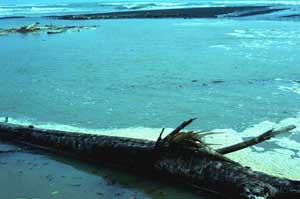|
|
 8 rafted spider DHJanzen101221.jpg high resolution
|
|
| A closer look at the log in image DHJanzen101220.jpg above reveals a spider web spun between the fragments of broken branch end and the main log, with a large and very alive female spider perched happily (?) in its center. Such a single spider now delivered to an island can easily establish a population, very likely having been fertilized before the trip. She can even walk up the cool beach at night to the vegetation above the high tide line. Furthermore, as an extreme generalist predator, she can perhaps survive on whatever species of insects are present. Small wonder that it is commonplace to find spiders (and ants) as THE terrestrial carnivores on small islands. While newly hatched spiders are very light and often wind-dispersed as part of their normal biology, the single new born spider being blown to an island has a major problem - where to find a mate. Rafting of adult females is quite a different manner. Interestingly, and quite serendipituously, adult spiders on webs turn out to be quite resistant to salt water splashed on them. | ||
back to lecture slides
or skip to: